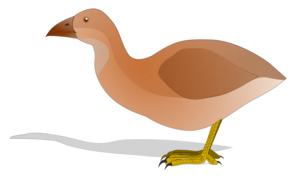- Adzebill
status = fossil
regnum =Animal ia
phylum = Chordata
classis = Aves
ordo =Gruiformes (but see article)
familia = Aptornithidae
familia_authority = Mantell, 1848
genus = "Aptornis"
genus_authority = Owen, 1844
subdivision_ranks = Species
subdivision =
* "Aptornis otidiformis" Taxobox_authority | author = Owen | date = 1844
* "Aptornis defossor" Taxobox_authority | author = Owen | date = 1871
synonyms =Genus-level:
* "Apterornis""A. otidiformis:
* "Aptornis otidiformes"The adzebills (
genus "Aptornis") were two closely relatedbird species , the North Island Adzebill, "Aptornis otidiformis", and the South Island Adzebill, "Aptornis defossor", of theextinct family Aptornithidae. The family was endemic toNew Zealand .They have been placed in the
Gruiformes but this is not entirely certain. It was also proposed to ally them with theGalloanserae (Weber & Hesse, 1995). StudiesFact|date=April 2007 of morphology andDNA sequence s place them variously close to and far off from theKagu ofNew Caledonia , as well as the trumpeters. Its morphological closeness to the Kagu may be the result ofconvergent evolution , although New Zealand's proximity toNew Caledonia and shared biological affinities (the two islands are part of the samemicrocontinent ) has led some researchers to suggest they share a common ancestor fromGondwana . If so, it is interesting to note that the GondwananSunbittern is most likely the closest living relative of the Kagu, and these two may also be reasonably close to themesites , yet other "odd gruiforms" from theSouthern Hemisphere , but do not seem to be close to the Gruiformes proper (i.e. cranes, rails and allies. See e.g. Fain & Houde, 2004 [Note that their proposed "Metaves " are only weakly supported, and contain several nigh-impossible grouping. A fairly close Kagu-Sunbittern relationship, on the other hand, seems almost certain by now.] ).On the other hand, should the adzebills be closer to the trumpeters, placement in the Gruiformes is likely to be correct even if the Kagu and Sunbittern are split off.In life the adzebills were massive gruiforms, the size of small
moa (with which they were initially confused with on their discovery) with enormous downward-curving and pointed bill, and strong legs. They were flightless and had extremely reducedwing s, smaller than those of thedodo compared to the birds' overall size, and with a uniquely reducedcarpometacarpus (Livezey, 1994).The two species varied mostly in size with the North Island Adzebill being the smaller species; their coloration in life is not known however. Their
fossil s have been found the drier areas of New Zealand, and only in the lowlands. Richard Owen, who described the two species, speculated that it was anomnivore , and analysis of its bones by stable isotope analysis supports this. Levels of enrichment in 13C and 15N for two specimens of "Aptornis otidiformis" compared with values for a moa,Finsch's Duck andinsectivore s like theowlet-nightjar s suggested that the adzebill ate species higher in the food chain than insectivores. [Worthy, T. H., Richard N. Holdaway (2002):p. 212] They are thought to have fed on largeinvertebrate s,lizard s,tuatara s and even smallbird s.The adzebills were never as widespread as the moa, but subjected to the same
hunt ing pressure as these and other large birds by the settlingPolynesia ns. They became extinct before the arrival of European explorers.References
* Fain, Matthew G. & Houde, Peter (2004): Parallel radiations in the primary clades of birds. "Evolution" 58(11): 2558-2573. doi|10.1554/04-235 [http://biology-web.nmsu.edu/houde/Parallel_radiations.pdf PDF fulltext]
* Livezey, Bradley C. (1994): The carpometacarpus of "Apterornis". "Notornis" 41(1): 51–60. [http://www.notornis.org.nz/free_issues/Notornis_41-1994/Notornis_41_1_51.pdf PDF fulltext]
* Weber, Erich & Hesse, Angelika (1995): The systematic position of "Aptornis", a flightless bird from New Zealand. "Courier Forschungsinstitut Senckenberg" 181: 292-301.
* Worthy, Trevor H. (1989): The glossohyal and thyroid bone of "Aptornis otidiformes". "Notornis" 36(3): 248 [http://www.notornis.org.nz/free_issues/Notornis_36-1989/Notornis_36_3.pdf PDF fulltext]
* Worthy, Trevor H., & Holdaway, Richard N. (2002) "The Lost World of the Moa", Indiana University Press:Bloomington, ISBN 0-253-34034-9Footnotes
Wikimedia Foundation. 2010.

